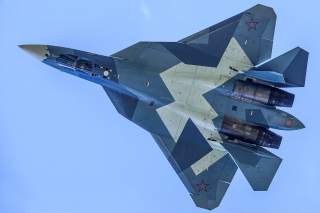Russia’s Su-57 Stealth Fighter Has a New Missile-Spoofing System
It doesn’t matter. Here's why.
Russia’s stealthy Su-57 is the only fighter in the world that features a Directed Infrared Countermeasures system, or DIRCM.
The presence of the missile-spoofing DIRCM turrets on the Su-57’s spine behind and underneath the cockpit point to a novel approach by Sukhoi designers to protect the fighter from infrared-guided missiles.
It’s not clear it will work. But the DIRCM is the least of the Su-57’s problems.
Connor Dalton, a self-described aviation “researcher,” pointed out the Su-57’s DIRCM in a post on Quora, the popular question-and-answer website.
“The system consists of two laser-emitting turrets, with one placed behind the cockpit on the dorsal side, and the other beneath the cockpit on the ventral side,” Dalton wrote. “The function of the system is relatively straightforward. When an I.R. missile is spotted, the lasers quickly aim for the missile’s seeker system, blinding it and preventing it from being able to guide to the targeted aircraft.”
“The thing is, the system has never previously been seen outside of transports and helicopters, and has only ever been placed on the ventral side in the past, as a defense against [shoulder-fired missiles].”
“So the presence of the dorsal mounting, and on a fighter no less, means that not only is this the first DIRCM system ever put into a fighter, it’s one of the first DIRCM systems ever made with the goal of combating air-to-air missiles,” Dalton explained.
It’s important to be skeptical of everything involving the Su-57. The stealth fighter first flew in 2010 but still hasn’t completed flight testing and lacks key systems. Production of the radar-evading, twin-engine fighter has proved difficult to scale. Sukhoi likely will struggle to fill, on time, Russia’s own orders for the type. Never mind building Su-57s for Algeria, Turkey, the United Arab Emirates and other countries that have expressed interest in the type.
The Russian air force possesses just a dozen or so of the type, which flew for the first time in 2010 but has suffered from a dearth of funding and the collapse of a co-development deal with India. One of the prototype Su-57s crashed in late December 2019.
As of early 2018, the Su-57 possessed “inadequate and incomplete sensors, incomplete fire-control systems and self-protection suites, no operational integrated avionics and ... unreliable engines,” Cooper noted. The type has conducted hardly any weapons-separation testing and lack any other operational weapons beside its 30-millimeter internal cannon.
The Russian air force in 2019 deployed Su-57 stealth fighters to Syria a second time since first deploying them to the war-torn country in February 2018. But the foreign forays apparently were for show. The stealth fighters apparently didn’t even employ any live weapons during their brief stopovers in Syria.
In deploying Su-57s, the Kremlin was “outright gambling with precious prototypes and their pilots’ lives,” according to Cooper. The aircraft were “flown by pilots who lack any kind of doctrine or tactics for the type and who cannot really depend upon the planes’ avionics and other systems,” according to Cooper.
Shortly following the 2018 deployment, the Kremlin suspended production of the Su-57 after the 28th copy, effectively canceling the program. Russian president Vladimir Putin dramatically revived the program in mid-2019, announcing a plan to buy an additional 48 copies.
The Kremlin ordered its first dozen production-standard Su-57s in August 2018, hoping to form the first regular squadron some time in 2019. With just a few days remaining in 2019, it appears unlikely the squadron will form on time. The delivery schedule includes just two new Su-57s in 2019 and an additional two in 2020.
The Su-57 program remains under-funded and under-developed. It’s one thing for Russia to announce an order for 48 more of the fighters. It’s another for the government actually to pay for the planes, and for Sukhoi actually to build them.
The Su-57 might feature a novel infrared-spoofing system, but unless Russia builds and deploys the type in meaningful numbers, new defensive systems hardly matter.
David Axe serves as Defense Editor of the National Interest. He is the author of the graphic novels War Fix, War Is Boring and Machete Squad.

